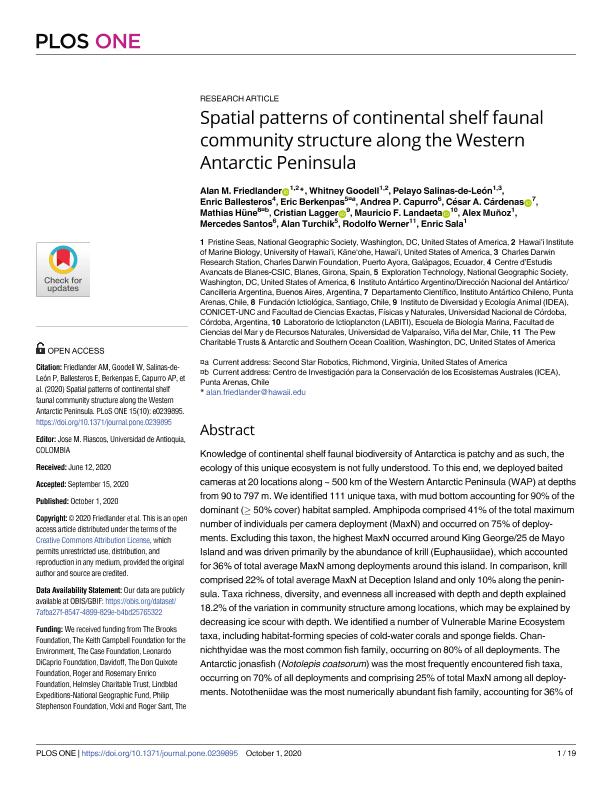Mostrar el registro sencillo del ítem
dc.contributor.author
Friedlander, Alan M.
dc.contributor.author
Goodell, Whitney
dc.contributor.author
Salinas-De-León, Pelayo
dc.contributor.author
Ballesteros, Enric
dc.contributor.author
Berkenpas, Eric
dc.contributor.author
Capurro, Andrea Paula

dc.contributor.author
Cárdenas, César
dc.contributor.author
Hüne, Mathias
dc.contributor.author
Lagger, Cristian Fabian

dc.contributor.author
Landaeta, Mauricio F.
dc.contributor.author
Muñoz, Alex
dc.contributor.author
Santos, Mercedes
dc.contributor.author
Turchik, Alan
dc.contributor.author
Werner, Rodolfo
dc.contributor.author
Sala, Enric
dc.date.available
2021-10-19T13:38:36Z
dc.date.issued
2020-10-01
dc.identifier.citation
Friedlander, Alan M.; Goodell, Whitney; Salinas-De-León, Pelayo; Ballesteros, Enric; Berkenpas, Eric; et al.; Spatial patterns of continental shelf faunal community structure along the Western Antarctic Peninsula; Public Library of Science; Plos One; 15; 10; 1-10-2020; 1-19
dc.identifier.uri
http://hdl.handle.net/11336/144249
dc.description.abstract
Knowledge of continental shelf faunal biodiversity of Antarctica is patchy and as such, the ecology of this unique ecosystem is not fully understood. To this end, we deployed baited cameras at 20 locations along ~ 500 km of the Western Antarctic Peninsula (WAP) at depths from 90 to 797 m. We identified 111 unique taxa, with mud bottom accounting for 90% of the dominant (≥ 50% cover) habitat sampled. Amphipoda comprised 41% of the total maximum number of individuals per camera deployment (MaxN) and occurred on 75% of deployments. Excluding this taxon, the highest MaxN occurred around King George/25 de Mayo Island and was driven primarily by the abundance of krill (Euphausiidae), which accounted for 36% of total average MaxN among deployments around this island. In comparison, krill comprised 22% of total average MaxN at Deception Island and only 10% along the peninsula. Taxa richness, diversity, and evenness all increased with depth and depth explained 18.2% of the variation in community structure among locations, which may be explained by decreasing ice scour with depth. We identified a number of Vulnerable Marine Ecosystem taxa, including habitat-forming species of cold-water corals and sponge fields. Channichthyidae was the most common fish family, occurring on 80% of all deployments. The Antarctic jonasfish (Notolepis coatsorum) was the most frequently encountered fish taxa, occurring on 70% of all deployments and comprising 25% of total MaxN among all deployments. Nototheniidae was the most numerically abundant fish family, accounting for 36% of total MaxN and was present on 70% of the deployments. The WAP is among the fastest warming regions on Earth and mitigating the impacts of warming, along with more direct impacts such as those from fishing, is critical in providing opportunities for species to adapt to environmental change and to preserve this unique ecosystem.
dc.format
application/pdf
dc.language.iso
eng
dc.publisher
Public Library of Science

dc.rights
info:eu-repo/semantics/openAccess
dc.rights.uri
https://creativecommons.org/licenses/by-nc-sa/2.5/ar/
dc.subject
ANTARCTICA
dc.subject
BENTHO
dc.subject
DEEP FAUNA
dc.subject.classification
Biología Marina, Limnología

dc.subject.classification
Ciencias Biológicas

dc.subject.classification
CIENCIAS NATURALES Y EXACTAS

dc.title
Spatial patterns of continental shelf faunal community structure along the Western Antarctic Peninsula
dc.type
info:eu-repo/semantics/article
dc.type
info:ar-repo/semantics/artículo
dc.type
info:eu-repo/semantics/publishedVersion
dc.date.updated
2021-09-06T15:43:26Z
dc.identifier.eissn
1932-6203
dc.journal.volume
15
dc.journal.number
10
dc.journal.pagination
1-19
dc.journal.pais
Estados Unidos

dc.journal.ciudad
San Francisco
dc.description.fil
Fil: Friedlander, Alan M.. National Geographic Society. Pristine Seas; Estados Unidos. University of Hawaii; Estados Unidos
dc.description.fil
Fil: Goodell, Whitney. University of Hawaii; Estados Unidos. National Geographic Society. Pristine Seas; Estados Unidos
dc.description.fil
Fil: Salinas-De-León, Pelayo. Charles Darwin Foundation Santa Cruz; Ecuador. National Geographic Society. Pristine Seas; Estados Unidos
dc.description.fil
Fil: Ballesteros, Enric. Consejo Superior de Investigaciones Científicas. Centre Destudis Avancats de Blanes; España
dc.description.fil
Fil: Berkenpas, Eric. National Geographic Society. Pristine Seas; Estados Unidos
dc.description.fil
Fil: Capurro, Andrea Paula. Ministerio de Relaciones Exteriores, Comercio Interno y Culto. Dirección Nacional del Antártico. Instituto Antártico Argentino; Argentina
dc.description.fil
Fil: Cárdenas, César. Instituto Antártico Chileno; Chile
dc.description.fil
Fil: Hüne, Mathias. Fundación Ictiológica; Chile. Centro de Investigación Para la Conservación de Los Ecosistemas Australes; Chile
dc.description.fil
Fil: Lagger, Cristian Fabian. Consejo Nacional de Investigaciones Científicas y Técnicas. Centro Científico Tecnológico Conicet - Córdoba. Instituto de Diversidad y Ecología Animal. Universidad Nacional de Córdoba. Facultad de Ciencias Exactas Físicas y Naturales. Instituto de Diversidad y Ecología Animal; Argentina
dc.description.fil
Fil: Landaeta, Mauricio F.. Universidad de Valparaiso; Chile
dc.description.fil
Fil: Muñoz, Alex. Pristine Seas, National Geographic Society; Estados Unidos
dc.description.fil
Fil: Santos, Mercedes. Ministerio de Relaciones Exteriores, Comercio Interno y Culto. Dirección Nacional del Antártico. Instituto Antártico Argentino; Argentina
dc.description.fil
Fil: Turchik, Alan. National Geographic Society. Pristine Seas; Estados Unidos
dc.description.fil
Fil: Werner, Rodolfo. The Pew Charitable Trusts & Antarctic And Southern Ocea; Estados Unidos
dc.description.fil
Fil: Sala, Enric. National Geographic Society. Pristine Seas; Estados Unidos
dc.journal.title
Plos One

dc.relation.alternativeid
info:eu-repo/semantics/altIdentifier/url/https://journals.plos.org/plosone/article?id=10.1371/journal.pone.0239895
dc.relation.alternativeid
info:eu-repo/semantics/altIdentifier/doi/https://doi.org/10.1371/journal.pone.0239895
Archivos asociados
